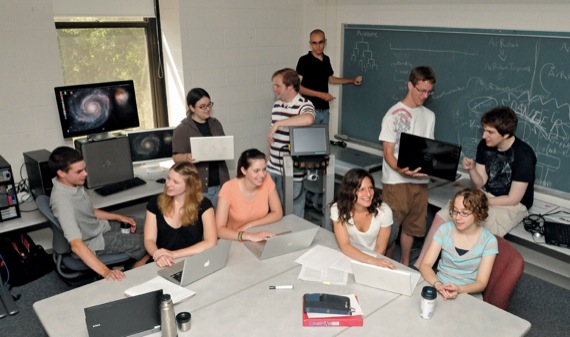 What summer vacation?
What summer vacation? What summer vacation?
What summer vacation?The work at Wheaton doesn’t stop when the semester ends in May. Many students (and even recent graduates) continue their scholarly pursuits on campus. These students spent summer vacation tackling innovative computer science research with their professors, Tom Armstrong, Michael Drout, Mark LeBlanc and Michael Kahn.
Stephanie Antetomaso ’12, a Balfour Scholar, independent studies linguistics major, and Phi Beta Kappa member, has assisted Professor Tom Armstrong in his research for two summers. She is developing algorithms to learn grammatical structures from language data. She traveled to Germany in August to present a paper on her work with the professor at the Joint IEEE International Conference on Development and Learning and the International Conference on Epigenetic Robotics. She also won second place in the 2011 Northeastern Computer Science Conference for student research.
Donald Bass ’12, a computer science major, Balfour Scholar and 2011 Presidential Award winner, is a software guru in the statistical programming language R. He solved a long-standing problem facing the lexomics group—how to extract data hidden in memory and translate it into a more standard format, "and he did it in two days,” notes Professor Mark LeBlanc. Bass plans to do an honors thesis this academic year with co-advisors LeBlanc and Professor Michael Kahn.
Emily Bowman ’13, an English major and Balfour Scholar, worked on several projects, including one with Phoebe Boyd ’12, surveying Beowulf scholarship from 1970 to 1980, and tabulating which date scholars assign for the composition of the poem in preparation for a paper that she, Phoebe and Professor Michael Drout had accepted for the Harvard "Dating of Beowulf” conference in September. She also worked to reorganize the massive J.R.R. Tolkien database, which has about 700 fully annotated entries.
Phoebe Boyd ’12, a history and English major and Mars Fellow, has been working on the Beowulf project with Emily Bowman ’13 and Professor Michael Drout, and on lexomics research. Her primary focus has been the Anglo-Saxon penitentials, a group of texts related to the practices of penance and confession in the seventh through 10th centuries. She has been working with Professor Mark LeBlanc to develop ways to make these files usable for lexomics research.
Anthony Castellani ’13, a Balfour Scholar and computer science major; computer science club president Christopher DeMolles ’13, a Balfour Scholar, who is majoring in mathematics and computer science; and Nathaniel Hunt ’13, who is double majoring in computer science and music, collectively, are exploring the varied uses of Wheaton’s Performance PeopleBot mobile robot with Professor Tom Armstrong. Last summer, they programmed the robot to explore areas of the Science Center while recording sensor data (sonar, bumpers, infrared sensors) about the robot’s environment. Using these data, they developed an approach that allows the robot to determine if its present location is similar to one it has been in before.
Amos Jones ’11, who majored in computer science, designed and implemented the lexomics group’s new online tool "diviText”(cs.wheatoncollege.edu/divitext) as part of his senior honors thesis. Last summer he was asked to stay on with the group as a National Endowment for the Humanities–funded consultant to prototype the new tool to help humanities scholars display experimental results on the web. He now works for the U.S. Department of Defense as an engineer.
Courtney LaBrie ’13, an English major and a Balfour Scholar, has been the lead investigator on an effort to apply lexomics techniques to texts from the Harlem Renaissance, particularly the play Mule Bone by Zora Neale Hurston and Langston Hughes. The play is famous for leading to the end of Hughes and Hurston’s friendship, as they quarreled over who had actually written it. "Our lexomics techniques have the potential to help solve this decades-old problem, as we think we may be able to detect which passages were written by which author,” says Professor Michael Drout. LaBrie has been compiling electronic corpora of Hurston’s and Hughes’s work for comparison, working with English professor Shawn Christian. One of the goals for this part of the project is to show that lexomics techniques work for drama as well as for poetry and prose.
Rachel Scavera ’12, an English major and Trustee Scholar, has been the lead on the content side of the Tolkien bibliography project, reading, summarizing, keywording and grading many articles on Tolkien’s work so that Wheaton’s database can continue to be the largest bibliographic resource in the world for Tolkien scholarship. She also has begun to experiment with lexomics techniques for modern English prose, trying to see whether it can be determined through lexomics techniques alone which sections of J.R.R. Tolkien’s The Silmarillion are based on the author’s older poems, which are originally prose compositions, and which were heavily edited or written by his son, Christopher Tolkien.
Photo by Keith Nordstrom